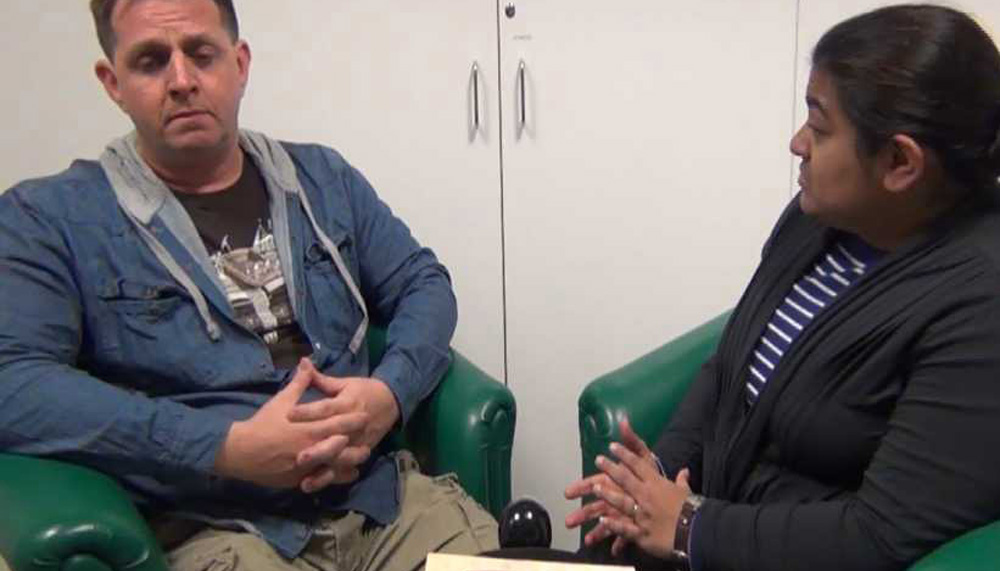Simulation has long been a part of training; but a unique program is now streaming mental health education over the web – and students love it.
Students on mental health placements can sometimes struggle to gain access to a wide range of patients. Some talented actors and the internet are helping to bridge the gap.
Nursing and medical students on mental health placement at St John of God Hospitals in Burwood and Richmond, NSW, as well as the organisation’s Pinelodge Clinic in Dandenong, Victoria, are now learning through simulations streamed over the web from Melbourne’s Centre for Health Innovation.
The program, in its second year of funding, involves actors helping educators deliver mental health simulations.
The simulations run for about 45 minutes at the start of a facilitated workshop that lasts three hours. The workshops are flexible and capitalise on whatever happened in the particular simulation.
“To try and simulate mental health is very difficult, which is why it has been in the Too Hard Basket for so long,” Richmond-based nurse facilitator Maria Field says. “The simulation provides us with a platform to launch off into a lot of different [directions] but the main thing we are looking for is empathy for nurses – so they can hopefully translate what they see into their nursing practice.”
Nurses often attend the hospitals on placement for anywhere from two to four weeks; Field says they benefit from the simulations’ uninterrupted, fly-on-the-wall view that gives students insight into illnesses they may not otherwise encounter.
“Students see this as a forum where they can get good feedback about their practice and where they can feel free to ask questions in an environment away from the units,” she says.
And they rave about the experience, expressing wonder and gratitude that the opportunity has been made available to them.
For example, one student says, “Today’s simulation was very enjoyable and well played, gave me good/new knowledge to help me with my approach to clients on my ward, to help me communicate.”
The process begins with highly detailed character briefings, rather than diagnosis notes. The aim is to create a high level of realism in every aspect.
Counsellor Ravi Iyer writes scenarios and also works with the simulated patients. He says those tasks are diametrically opposed to his role of a clinician.
“I go out into the community and observe people [to create the scenarios],” Iyer says. “I also pull from my own history of work, relationships and reading – both fiction and non-fiction. Then I have to crystallise what I’ve seen into language that can help an actor bring the person to life.
“Working with the actors is an expedition in amazement. Their ability to transform so utterly and absorb themselves into another person is incredible. I never doubt that I’m working with anyone other than an actual patient.”
Scott Gooding is one actor who has worked with Iyer. He plays the role of Jeremy Black, a 37-year-old man with a long history of depression. In the simulation, Jeremy is an inpatient undergoing electro convulsive therapy, with the result that he is now motivated to carry out his suicide plan. Iyer recalls the moment when the “emotional floodgates” opened and Jeremy disclosed his plans.
“It was powerful and I felt tenderness and respect,” Iyer says. “It was a defining moment of human fragility.”
Gooding works regularly in simulation and particularly enjoys the challenge that Jeremy presents.
“I have to slow right down and take the time to understand what’s inside Jeremy’s head,” he says. “He’s constantly grappling with a desire to be honest but also not reveal too much.”
At the end of the clinical interaction, both the clinician and the actor offer their perspective on what just happened. Students then have the opportunity to question both people. Clinicians and actors working in the simulations need the capacity to be present but also observant and reflective.
Gooding says that’s all part of the job: “I can de-role quickly. And while I’m deeply involved with Jeremy, I’m not Jeremy. There’s a distance and this is what enables me to reflect and observe.”
Kim Denman fills in as director/producer when required and has also played the role of Jennifer Wallace, which Iyer wrote. Jennifer is a socially isolated 48-year-old woman who is addicted to playing poker machines.
“As an actor, it’s creatively satisfying to play such a complex, layered and real human being,” Denman says. “It’s more than just answering questions, like in many simulations.”
To help prepare, Denman spoke to her brother, who has been in rehabilitation for his own gambling addiction. She was able to gain valuable insight into what life is like for someone living with a gambling addiction. He was able to share details that weren’t in the brief, but helped make it real.
This highlights the value professional actors add to the simulations, and those working on the project regularly express satisfaction at being able to support the education of people in healthcare.
Iyer says he certainly didn’t have access to anything like this during his training.
“It’s invaluable for students who are soon to enter the industry to see what happens in the consulting room,” he says. “It’s a soft introduction that paves the way into debate and discussion about the merits of particular approaches. I also get the opportunity to reflect on my own practice.”
Fourteen of the patient scenarios have been filmed and a DVD library and facilitator toolkit are in production. The resources will be made available as an educational tool for anyone working in or studying mental health.
Tanya Edlington is project manager of the simulated learning environment at St John of God Health Care.
The project was possible due to funding made available by Health Workforce Australia.
Do you have an idea for a story?Email [email protected]
 Aged Care Insite Australia's number one aged care news source
Aged Care Insite Australia's number one aged care news source

